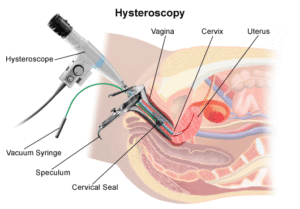
Some women may have difficulty conceiving because of problems in their reproductive system. These range from a congenital malformation (birth defect) of the uterus or absence of a vagina, to acquired abnormalities such as polyps, fibroids or endometriosis. If such a condition is found during fertility evaluation, one may need surgery to correct the problem.
Hysteroscopy is a procedure that allows one to look inside your uterus in order to diagnose and treat various conditions. It is done using a hysteroscope, a thin and small, telescope-like instrument is inserted directly into the uterine cavity. The scope allows the surgeon to visualize the uterine cavity and to diagnose conditions such as uterine septum — protrusion of the upper wall of the uterus into the cavity — scar tissue (adhesions), uterine polyps, endometriosis or uterine fibroids. This is an outpatient surgery, and it does not require an overnight stay.
Is a hysteroscopy painful?
During a hysteroscopy one may experience some discomfort relatable to the discomfort of period cramps. The level of discomfort depends on whether any anaesthetic drugs have been used or not, the type of hysteroscope used and whether previously the patient has undergone any birth or vaginal
procedures How long does it take to get over a hysteroscopy?
Hysteroscopy is a short procedure taking anywhere between 10-30 min depending on what is being done.
What to expect during hysteroscopy?
Hysteroscopy can lead to diagnosis as well as treatment of any condition found during the procedure. The recovery is generally quick with only minor cramps and minimal bleeding.
Risks/Complications
Hysteroscopy is generally a safe procedure and complications are uncommon
© 2019 Dr.PRAJNANIKA All Rights Reserved.
Website By Digital Web Avenue